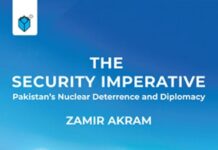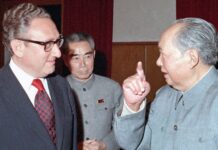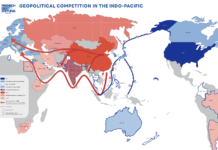Sabtain Ahmed Dar
In his 1940 classic entitled The History of Afghanistan, Brig.-Gen. Sir Percy Sykes keenly observed the Afghans during the First Afghan War. According to him, “the inhabitants of Kabul manifested the most complete indifference to their new sovereign, and exposed no sign of welcome or satisfaction at his accession to the throne. Evidently, their hearts and affections were with their previous sovereign, now a wanderer beyond the Hindu Kush.” Like Britain, the United States also faced the same Afghan behavior when it invaded Afghanistan to eliminate terrorism and propagate the idea of liberal democracy in that country.
The history of Afghanistan has taught us that any foreign ideology that intervenes in its social fabric does not last long, for the Afghans stick to their age-old customs and tribalism that govern them. During the period of colonization, when the Durand Line was formed in 1893, the seeds of future conflicts were sowed by Britain.
Ever since the creation of Pakistan , the Pashtun factor has been a key in determining mutual relations between Afghanistan and Pakistan. In their 2017 seminal work entitled Pakistan-Afghanistan Relations: The Pashtunistan Factor, Professor P. Moorthy and Dr. Muzammil Ahad dwell into understanding the Durand Line and how it has triggered tensions between the two neighbors. Pakistan is a country that shares a 2,670-km-long border with Afghanistan. This is why it has lost a lot due to instability and chaos in Afghanistan since 1979. That trouble in Afghanistan directly disturbs Pakistan’s security and economy is one of the reasons why it continues to remain an important stakeholder in Afghanistan. Pakistan was, after a lapse of 18 years, able to facilitate direct negotiations between the Afghan Taliban and Washington that led to the withdrawal of U.S. forces and the return to power of the former.
The post-US withdrawal developments in Afghanistan are but a cause of concern for Pakistan. The country is perturbed about the unfolding economic and humanitarian crises in Afghanistan. This is why Islamabad is urging world capitals not to abandon that country while arguing that doing so would make it a fertile ground for terrorism and militancy. In such a milieu, the importance of healthy Pakistan-Afghanistan relations has increased. U.S. scholars Elizabeth Threlkeld and Grace Easterly also look at the importance and impact of Pak-Afghan relations in their co-authored report entitled Afghanistan-Pakistan Ties and Future Stability in Afghanistan. The report, relying on interviews of experts, tries to analyze the future of Pak-Afghan relations.
Threlkeld and Easterly look at five themes in Pakistan’s relations with Afghanistan, with a view to analyzing and recommending a workable future pathway. Starting from sovereignty, security, and geopolitical interests, the authors go on to highlight two major themes in Afghanistan-Pakistan relations – cross-border links and trade & connectivity. Although the report will have to be updated, as it was published before the Taliban takeover on August 15, yet it successfully touches upon and highlights major dynamics relating to security and connectivity. Talking about sovereignty concerns, Threlkeld and Easterly argue that the Durand Line has inflicted wounds in between the two neighbors. Despite the prolonged border conflict, the authors identify Pakistan’s successful effort to resolve border disputes with Afghanistan during the Zulfiqar Ali Bhutto administration in 1976. This was an era when Pakistan under Bhutto, Iran under Shah Reza Pahlavi, and Afghanistan under President Daoud were experiencing great mutual relations. But these efforts came to dust in few years when these three leaders were ousted by the new regimes in their respective countries.
In relation to security concerns, the author point out Pakistan’s strategic thought vis-à-vis Afghanistan and India. They argue that, “ Pakistan views its security interests in Afghanistan predominantly through the prism of its regional rival and neighbor India.” Indeed it is true in the context of Pakistan’s threat perception, as it would not want to be sandwiched between conflicts from all sides. The authors take the case of Pakistan’s support to Hizb e Islami and the Taliban during Afghanistan’s civil war in the 1990s .They write: “To securing influence in Kabul, Pakistan’s military and ISI calculated that their support for the Taliban would ultimately force surrounding states India, Russia, and Iran to accept the group and give Pakistan added leverage.” It is evident that, at one point, all that Pakistan wanted was a setup in Afghanistan which was not anti-Pakistan. Apart from the support to Afghan Mujahedeen against Soviets, there is no empirical proof of Pakistan’s support to the Taliban in Afghanistan during the 1990s, especially till the capture of Kabul. Pakistan was a signatory to the Geneva Accords that compelled Afghanistan’s neighbors to not interfere in its internal affairs. Pakistan has been blamed rather unfairly for exploiting Afghanistan to gain strategic depth. Pakistan’s leverage over the Taliban has been overstated. However, it is a harsh reality that Afghanistan, since centuries, has been used as a buffer zone between the great powers who sought this very strategic depth in this region.
Dismissing Pakistan’s stand, the authors point that, “the presence of al-Qaeda in Afghanistan, enabled by the Pakistan-backed Taliban, speaks to the global impact of regional security calculations. Pakistan likewise shaped external involvement in its decision to ally with the United States yet maintain links to Taliban fighters.” Threlkeld and Easterly analyze Pakistan’s dealing with the U.S. through the prism of realpolitik where Pakistan, on the one hand, partnered the U.S. to extract lucrative financial and military succor while, on the other, maintained secret ties with the Taliban to sideline U.S. interests in the region. This narrative of Pakistan’s double game has vitiated relations between the two.
Concerning cross-border links and connectivity, the authors take the past forty years into account and how they shaped the relations between the two neighbors. They argue that, “Afghanistan-Pakistan relations have long been driven by cross-border people-to-people relationships, including the movement of refugees as well as familial, commercial, and communal ties spanning the Durand Line.” Indeed, the Afghans have merged into Pakistan’s social fabric. The Afghans and their families have been contributing through their businesses in major commercial cities such as Peshawar, Quetta, Rawalpindi, Faisalabad, Lahore, and Karachi.. Threlkeld and Easterly argue that “[Pakistan] is increasingly seeking to focus on geo-economic connectivity to Central Asia over traditional geopolitical interests.” The authors see this trade and connectivity phenomenon positively for the mutual relations between Afghanistan and Pakistan. However, it would still depend on what policy the Taliban will follow with Pakistan in relation to Pakistan’s objective of gaining a foothold in Central Asia.
As the report was published before the Taliban takeover, Threlkeld and Easterly rightly analyze the future of Pak-Afghan relations by looking at three scenarios:
1- Negotiated Settlement
2- Civil War
3- Taliban Takeover
Although the present outcome in Afghanistan is in line with the third scenario, it is important to reflect on the other two scenarios, too. In relation to a negotiated settlement, the report aptly points out that “the Taliban, believing itself to be an ascendant power, is unwilling to make concessions, as is the Afghan government, which seeks to maintain its waning influence.” The chances of a negotiated settlement ended quicker than expected. It was not expected that the Afghan government and its entire apparatus would collapse even before the last U.S. soldier left Afghanistan. Not many expected that President Ashraf Ghani would flee the country to the United Arab Emirates (UAE) despite the Taliban’s call for general amnesty and negotiations to form a broad-based government. The Taliban’s takeover was facilitated and enabled by the capitulation of the Afghan National Defense and Security Forces(ANDSF) and Afghan intelligence agencies. The report points out, however, that other Afghan leaders “are reconstituting militia forces similar to those that dominated the civil war three decades ago as they seek to secure their interests along tribal and ethnic lines.” Contrary to this, the Taliban made concessions and personally visited these leaders to eke out a just settlement; this strategy prevented a civil war.
Apart from the three future scenarios, the authors give ‘India’ an exclusive space in their predictive analysis. They rightly argue that, “one major challenge to improved Afghanistan-Pakistan relations in these scenarios is the role India would play, either as a partner in development assistance or as an actor seeking to protect its security interests.” It is true that India is concerned with the emergence of the Islamic Emirate of Afghanistan. Indian geopolitical pivot in Central Asia has always been incomplete without assistance from the United States. U.S. withdrawal from Afghanistan puts India into a disadvantageous position, in which it is finding it hard to gain political ground in the emerging dispensation in Afghanistan. With Taliban in control of Afghanistan it is plain and clear that India cannot really bank on the North South Transport Corridor (NSTC) for long. However, it still depends on what foreign policy, under Mullah Mutaqi, the Emirate would adopt after the formation of a stable government. It is apparent that India has no choice left expect to work with the IEA. If India does not cooperate or recognize the new government under the Taliban in Afghanistan, its land access to Central Asian markets through Iran would be choked. Therefore, New Delhi would most likely seek a balanced policy where it would secure its national interests in the region based on geoeconomic goals.
After analyzing the role of India, the authors take the geopolitical dynamics into account. The authors argue that ” states across the region with a stake in Afghan stability—among them Iran, Russia, China, and the Arab Gulf States—would likely feel compelled to increase their involvement should conditions in Afghanistan deteriorate.” During the Covid-19 pandemic, almost every state is experiencing a financial crunch because of lacklustre economic activity. Therefore, the influx of Afghan refugees is not in the interest of any state at the moment. As the situation in Afghanistan did not deteriorate it was not surprising to see that China and Russia did not evacuate their diplomatic staff from Afghanistan. This speaks volumes about the pragmatism of the two great powers of Eurasia. As the authors point out the dynamics of regional competition, it is true that China sees US withdrawal as an opportunity to connect Afghanistan with its Belt and Road Initiative (BRI). China’s land access to Afghanistan is through Wakhjir Pass. It was tightly closed by throughout the period of the Afghan war, to avoid an influx of non-state actors in its Xinjiang province which is predominantly Muslim. Russia also seems to be pragmatic in dealing with the Taliban at this time. Russia’s grand strategic objectives are linked to its vision of the Eurasian Economic Union (EEU). President Putin’s statements depict his understanding of Russia’s role in Afghanistan and he seems to be willing to deal with the Taliban. The Central Asian Republics (CARs) are known as ‘Russia’s sphere of influence’; by all means, Russia will continue to engage the Taliban diplomatically to preserve its classic fabric in the region.
Threlkeld and Easterly then move on to recommend policies and their implications through the prism of regionalism and internationalism. In the context of regionalism, the authors recommend policy options for both Afghanistan and Pakistan to hold direct and inclusive talks. Apropos of track 1 dialogues ,the report recommends high-level officials to hold direct talks to maintain good relations amongst each other, in which influential Pashtun representatives and people from diverse backgrounds must take part. The authors stress the need to eradicate controversies and disputes through dialogue. In doing so, the report suggests both countries to continue the mechanism of the Afghanistan-Pakistan Action Plan for Peace Solidarity (APAPPS) established in 2018, to improve various facets of their relations. Although this framework has lost its value as it was established under the Ghani administration, a similar framework can be used by both Afghanistan and Pakistan, to chart a new path to avoid tensions.
The report then recommends a policy where bilateral topics, such as border management options, increased intelligence sharing, and military-to-military engagement should be of prime focus. It is indeed practical as the region is still suffering from the menace of terrorism. Thus, counterterrorism cooperation between Afghanistan and Pakistan against these groups can play a crucial role in maintaining security of the region. On the question of the Pashtun Tahafuz Movement (PTM) and its alleged support from Afghanistan, the authors recommend Islamabad to adopt a pragmatic policy of inclusiveness that can sustain the interests of all parties. The prime notion behind this policy is to create an environment for cooperation on post-conflict reconstruction of Pashtun-majority areas in Pakistan. The erstwhile tribal areas of Pakistan have suffered the most in the war on terror. Addressing Pashtun concerns over human security are indeed a challenge for Pakistan’s policymakers. Therefore, Threlkeld and Easterly rightly recommend confidence-building measures (CBMs) through which Islamabad and Kabul can stabilize their relations going forward.
The report lays emphasis on trade, investment, people-to-people exchanges, and military exercises. It is indeed a fact that trade and cultural exchange programs have been affected greatly due to the four decades of war in Afghanistan. These two aspects have greatly hampered relations and have had a negative impact on the younger generations of the two countries. The authors recommend the governments of the two countries to ease restrictions on traders who can play a crucial role in domestic economies. Afghans should be encouraged to have bank accounts in Pakistani banks to swiftly engage in financial transactions. The Afghan government should also allow and facilitate Pakistani investors to invest in Afghanistan. On the other hand, students from both countries should be given scholarships to study in universities. Pakistan is already doing so. This is indeed practical as it will not only enhance people-to-people exchanges but also prepare future generations of both countries to build a relationship based on trust and understanding.
In relation to internationalism and Afghanistan, the report considers United States and third parties’ role to be crucial. Threlkeld and Easterly argue that both Afghanistan and Pakistan must be encouraged by the U.S. to not indulge in activities for international point scoring but to work towards having good bilateral relations. Also, third parties must be patient in allowing the two countries to understand and find a common ground between each other. The authors point out that both states can be brought together to work on a mechanism where United States and third parties can act as guarantors of commitments made during the negotiations. However, the actors who can spoil peace efforts between the two neighbors must be anticipated. The report recognizes non-state actors such as Jaish-e-Mohammed, Lashkar-e-Taiba, and Indian proxy support as some of the spoilers for regional peace. Considering Indian claims against alleged Pakistani proxy groups in Kashmir and Pakistani claims of TTP having Indian support should be cleared through maintaining backchannel contacts between India and Pakistan. As Taliban takeover had already happened, Pakistan hosted a meeting of spymasters from China, Russia, Iran, and Central Asian states in an attempt to ensure that all parties must remain sincere to peace. A similar framework with India can also be established on bilateral lines through which the alleged proxy war between the two states can be diminished. However, the prospect of New Delhi and Islamabad talking on this issue is dim.
The authors point out that “ opportunities for trade, investment, and cross-border engagement—the final recurring theme in Afghanistan-Pakistan relations—could provide immense benefits to both sides via connections to Central Asia.” It is very true and perhaps the only way forward for the region. A foreign policy that aims at achieving geopolitical objectives by exploiting the land and people of the other nation is bound to fail in the long run. Afghanistan has been the best case study to understand this geopolitical phenomenon. Hence, Threlkeld and Easterly policy recommendations in relation to identifying the fault lines that are creating tensions between the two countries, are useful. A policy through which Afghanistan’s neighboring states, including Pakistan, would respond to the echoes of distressed Afghans and help them in rebuilding their country, should be adopted.
Sabtain Ahmed Dar is a Lecturer in the School of Integrated Social Sciences, University of Lahore.

















